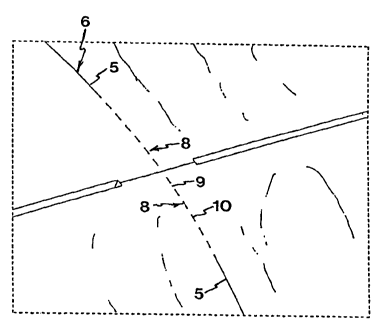Note: Descriptions are shown in the official language in which they were submitted.
-
~ W095/05264 PCT/SE9~/00752
21~6~8
fflETHOD OF MANUFACTURING A ROTARY DIE ~U~l~G MACHINE,
AND PART OF SUCH A MACHINE
This invention relates to a method of manufacturing
a rotary die cutting machine, as well as part of such a
machine.
Ba~kylo~d of the Invention
In a prior-art method of manufacturing a rotary die
cutting r~hine destined to cut e.g. package blanks, a
reduced drawing illustrating the design of the package is
glued onto a wooden drum. The contours of the drawing are
then followed and sawn by hand. However, this method is
old-fashioned in many respects, and is neither accurate
nor reliable. For instance, the prebored holes, which are
needed for introducing the saw blade, prevent the
inserted cutting rules from being firmly ret~in~.
In recent years, laser has instead been used for
cutting the groove pattern in the wooden drum, such
grooves providing a much better grip for the cutting
rule.
All cardboard cutting m~.hi n~.~., flat die as well as
rotary die cutting ma~h; n~.s, are manufactured with a
bridge system, the size of the bridges and their posi-
tions on the drum being determin~ when the cutting
machines are constructed. This is done in order to eli-
minate the "jig-saw-puzzle effect", i.e. to make all the
pieces of the drum stick together. The bridges have a
length of 8-lO mm.
Problem of the Invention
The wooden drum is usually composed of two semi-
cylindrical parts. It has, however, been found that
not even laser-beam-cut grooves adjacent to the joint
between these two parts are able to retain in reliable
fashion the cutting rules ext~n~ing in the circumferen-
tial direction of the drum, probably because the stresses
in the cut drum may act freely at the joint-defining
WO95/05264 ~ PCT/SE94/00752
edges of the drum parts. Thus, the cutting rules have
shown a tendency to straighten out at the end of the
groove curvature adjacent to these edges.
Object of the Invention
The object of the invention is to solve the above-
mentioned problem.
Sl -~y of the Invention
According to the invention, this problem is solved
by means of the chain bridges defined in the appended
claims and the following description, which replace the
prior-art circumferential groove portions adjacent to the
joint between the drum halves.
Description of an Embodiment of the Invention
An embodiment of the invention is illustrated in the
~c~ompanying drawings, in which
Fig. 1 is a plan view of two drum halves,
Fig. 2 is a perspective partial view of a drum half
which is partly provided with cutting rules, and
Figs 2A and 2B are enlarged views of the components
framed by ~he~ lines in Fig. 2.
Fig. 1 shows a wooden drum consisting of two drum
halves 1. The joint between the drum halves is designated
2. The drum halves 1 are provided with a laser-beam-cut
groove pattern 3 for cutting and scoring blanks for two
four-point-glued trays of corrugated cardboard. The
groove pattern 3 is conventionally produced, such that
8-mm-long bridges 4 remain between the cuts or slits 5.
Cutting steel rules, which have been provided with
recesses for straddling the bridges 4, are inserted in
the grooves 6 consisting of the bridges 4 and the cuts 5.
According to the invention, those parts of the cir-
cumferential grooves 6 that are located adjacent to the
drum-half edges defining the joint 2 are broken, i.e.
consist of a chain bridge 8 of 4-mm-long bridges 9 alter-
nating with 4-mm-long cuts or slits 10, one such bridge 9
defining the edge of the drum halves.
~ W095/05264 2 1 ~ 9 ~ 5 8 PCTtSE94/00752
At the top of Fig. 2A, an arcuately bent cutting
rule ll is completely inserted in a circumferential
groove 6, and at the bottom of Fig. 2A, such a cutting
rule 12 is but partly inserted in a circumferential
groove 6. It is evident from the Figure that the cut-
ting rules ll, 12 are recessed at regular 4-mm intervals
in the longitudinal direction so as to fit in the chain
bridges 8. The chain bridges 8 have a length of about
70-80 mm, but they may have any optional length, depend-
. lO ing on the design of the package and its placement on thedie.
